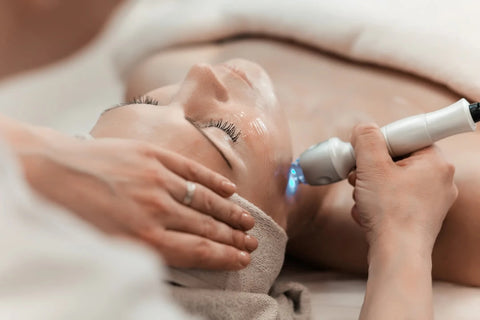You have no items in your bag
A skin resurfacing treatment aims to rejuvenate skin for a healthier, younger-looking complexion, but what is it?
Product Recommendation for Skin Resurfacing Treatments: Regenerating Skin Nectar with TriHex Technology®
A skin resurfacing treatment aims to rejuvenate skin for a healthier, younger-looking complexion, but what is it?
Product Recommendation for Skin Resurfacing Treatments: Regenerating Skin Nectar with TriHex Technology®

A skin resurfacing treatment aims to rejuvenate skin for a healthier, younger-looking complexion. During this type of skin treatment, a plastic surgeon, dermatologist, or skin professional will administer the removal and remodeling of damaged skin. In doing so, the skin is placed in a controlled "wounded state" in order to encourage elastin and collagen production and reveal new, healthier looking skin. Common non-surgical skin resurfacing procedures include Chemical Peels and Lasers.
These skin resurfacing procedures are non-surgical and typically involve minimal healing time. The following are some of the most common skin concerns that skin resurfacing aims to treat:
When considering a skin resurfacing procedure, it’s important to also take procedure skin care into consideration. At ALASTIN, our professional procedure enhancement skincare products are specifically designed for pre- and post-procedure care to enhance patient's treatment results. Our procedure products are formulated with TriHex Technology® to support the process of restoring and rebuilding skin to help promote faster healing. To support chemical peel and laser procedures, we recommend Regenerating Skin Nectar with TriHex Technology®.
Regenerating Skin Nectar
Consult with a doctor or skincare professional to see if a skin resurfacing procedure is right for you.
There are a few skin resurfacing treatment options available, including different types of chemical peels and laser resurfacing treatments. We've outlined some of the most common procedures below:
A chemical peel is an aesthetic treatment designed to improve the appearance of the skin on the face, neck, décolleté or hands. Depending on the treatment, a peel will often be classified as light, medium, or deep. This classification refers to how deep the peel penetrates in the layers of skin. The skin resurfacing procedure uses a chemical solution that is applied to the skin to cause exfoliation and eventually peeling over the days to follow.
Benefits of a Chemical Peel:

After the initial healing period from a chemical peel, patients will see some early improvements such as tighter-feeling skin, even skin tone and a brighter complexion. With the lighter-medium peels, repeat treatments periodically are often recommended for optimal outcomes.
There are hundreds of different technologies currently available to address the visible signs of skin aging. One such technology is the Laser, which stands for “Light Amplification by Stimulated Emission of Radiation.” Lasers use highly concentrated beams of light energy, and when used for resurfacing, remove the outer layer of skin, called the epidermis. Simultaneously, the laser energy heats the underlying skin called the dermis, and together this procedure will improve the skin’s overall tone and texture to reduce facial wrinkles, dark spots, blemishes and even some scars.
Benefits of a Laser Skin Resurfacing Treatment:

Types of Laser Treatments for the Face:
Ablative Lasers: Ablative lasers remove outer layers of skin, called the epidermis, and encourage new skin to regenerate in its place. The depth of laser penetration will depend on the wavelength of the light. Fractionated ablative lasers are being used more frequently because they break up the laser energy into thousands of tiny beams to treat only a small fraction of the skin in the area, which reduces downtime by not completely removing the outer layers of the skin. The improvements from laser resurfacing are long-lasting and dramatic, but they can appear gradually over time as healing and new collagen regeneration take place. It can take many months before you see the final results from the procedure. There is typically some downtime with these procedures that can range from 3-10 days depending on the type of procedure performed.
Non-Ablative Lasers: A non-ablative laser skin rejuvenation treatment uses a laser to improve the appearance of wrinkles, brown spots and minimal or superficial scars by creating heat in the skin without injuring the top layer of the skin. The heat generated by the resurfacing laser promotes collagen production which causes the skin to contract and tighten for a younger and healthier appearance. Non-ablative lasers can also be fractionated, meaning they deliver heat into the skin through thousands of tiny, deep columns known as microthermal treatment zones with normal untreated skin in the surrounding areas. Fractionated lasers allow the skin to heal much faster, reduce the recovery time, and reduce the number of complications that can potentially occur. Oftentimes, multiple sessions are required for optimal results, though there is typically no downtime with non-ablative laser procedures. The skin may experience redness, appear pink, and have a sand-paper type texture for a few days. If you are concerned about the redness, read our blog on how to reduce redness after laser treatment.
Consult with a doctor or skincare professional for more information on healing time and efficacy for your skin type. For patients interested in skin rejuvenation or another cosmetic procedure, make sure to utilize pre-treatment skincare two weeks prior to the scheduled procedure date to maximize procedure results and minimize downtime.
Contact your physician today to find out which skin resurfacing treatment is right for you.
Regenerating Skin Nectar with TriHex Technology® is clinically proven to enhance Fractional Laser Resurfacing results:
$258.00
$84.00
$98.00

"I love using ALASTIN Skin Nectar both prior to laser procedures and after laser treatments to optimize the results of the laser treatments. The benefit of using Skin Nectar prior to laser treatments is that it prepares the skin for the collagen and elastin remodeling that occurs after the laser procedures. I always apply it immediately after the procedure to help alleviate the initial burning or heat sensation that occurs. Then, I encourage my patients to use it for 2 weeks after the laser treatments in order to minimize the redness, decrease the downtime, and also enhance the results. I personally use the product and believe in the real science behind it."
Dr. Nazanin Saedi
Jefferson Laser Surgery and Cosmetic Center

“ALASTIN Regenerating Skin Nectar is one of the best-selling products in my office. It not only works to enhance post-treatment recovery (such as non-ablative laser treatments) but patients fall in love with it once they feel it and want to continue using it even after recovery. I recommend it also for rejuvenation, along with its sister product ALASTIN Restorative Skin Complex.”
Dr. Lorrie Klein
OC Dermatology>
